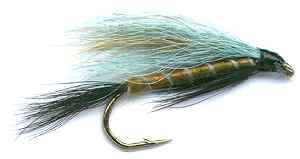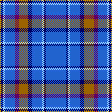TAR16-H. The Irish Clan Cian
Single Hook
Hairwing Tartan Fly


![]()
![]()
![]()
![]()
![]()
![]()
![]()
TARTAN FLY PATTERNS OF SCOTLAND. Hook size 8 - $US each








Irish Tartans
There are very few Irish family tartans, unlike Scotland where there are hundreds. Most people of Irish
heritage wear the tartan of the County or Province where their families lived.
Clan Cian
Clan Cian is one of the few Irish families
that have their own tartan. The Clan Cian was also known as the Cianachta, Race
of Cian, who was the youngest Son, of Olioll Ollum King of Munster, and
Grandson, of King Eoghan Mor 1st (known as) Mogh Nuadath de Leith Mogha
(Mogha’s Half) of southern Ireland of the Milesian race of Heber, who contested
for supremacy of all Ireland in the second century of the Christian Era.
The Clan Cian (Cianachta were led well over 1500 years by an officially recognized King or High Chief, Prince or Ruling Lord (Irish "Ard Tiarna") chosen from members of the Carroll-O’Carroll, Rival Houses of the noble Sept of Eile O’Carroll.
Anciently settled in Ormond. Counties Tipperary, Waterford. and Eile O’Carroll, extending into Offaly, Leix, Kilkenny. In the fifth century the Cianacht Chief, Eile Righ Derg (Eile the Red King) ruled the territory known as Eile O’Carroll to distinguish the Sept from other O’Carroll Septs.
The name O'Carroll is derived from Cearbhaill, (Irish "Warrior Champion" or, more accurately rendered, "Slaughter"), and Son of Aedh, who was Chief of the Cianachta and King of Eile. Prince Cearbhaill led the Eilians for King Brian Boru at the Battle of Clontarf 1014. The name Carroll is distinctly Irish. There are no other forms of it found anywhere. If you hold the name of Carroll, you have Irish ancestry within you somewhere.
![]()
![]()
![]()
![]()
![]()
![]()
![]()
After the Norman invasion, the Butler family, originally known as Fitz Walter, gained control of much of Ormond. The O'Carrolls maintained dominion of a area of about 300,000 acres, today known as the Eile O'Carroll Territory, up until the Cromwellian Invasion and the collapse of the Gaelic Order in the 1600's. It consisted of eight tuathas or baronies, each ruled by a chief subordinate to the Eile O'Carroll sept. It is centred around the towns of Birr in County Offaly and Roscrea in County Tipperary, extending north to above Banagher and south-west along Lough Derg to below Nenagh, then east to the Slieve Bloom Mountains. This is the very Heart of Ireland.
The Clan Cian Tartan is registered with the Scottish Tartans Society of Scotland. It was further posted with the Chief Herald of Ireland as a certified tartan for use by the Clan Cian-O'Carroll (Ciannachta) of ancient Ormond and the Eile O'Carroll Territory. Other related clans with different family names are also authorized to use the tartan, such as those of the Dal gCas (Dalcassians) of Thomond and the Eugenians (Eoghanachta) of Desmond.
By charter of agreement this tartan is to be used universally by the Dalcassian, Ciannacht, and Eoghanacht family septs, as well as the dependent and related septs of the Province of Munster and other parts of Ireland. If you have the blood of any of these clans in you are authorized to wear the Tartan.








The traditional colors for the Irish Republic were green with a gold harp, but that was later changed to blue with a gold harp. The Clan Cian Tartan includes the primary colors of the traditional coats-of-arms of the ruling families of these kingdoms. The primary color of blue represents the province of Munster and the Republic of Ireland.
The surname Carroll has a very old history, and when translated from the Irish , Cearbhaill,(pronounced just like Carroll) means slaughter, or preferably, warlike champion. The name Carroll is distinctly Irish. There are no other forms of it found anywhere. If you hold the name of Carroll, you have Irish ancestry within you somewhere. The family coat of arms shown here at the top of my page, basically represents all Carrolls worldwide, however most all Carrolls now associate themselves with the Carrolls of Ely, and their coat of arms. The inscription Flecti Non Frangi, means something along the lines of "Bent, but not broken".The O'Carrolls descend from Milesius, king of Galacia in Spain, by way of Heber, his son. Heber was the first Milesian king of Ireland, about 1699 BC. His reign lasted but a year, when he died. His brother Eremon succeded him and ruled Ireland for the next 14 years. The O'Carrolls also descend from Kian, the grandson of Owen the Great, who was victorius over Conn, the 110th High King of Ireland who ruled during the second century.
The Carroll history however, is not filled with family unity. In fact throughout most of their history, they were very busy fighting one another for control of the princepalities. They became known throughout Ireland for their savage and brutal war-like activities.
![]()
![]()
![]()
![]()
![]()
![]()
![]()
In 1014, after two hundred years of constant war and invasion by the Vikings, High King Brian Boru of Ireland enlisted a great army to meet the Danes, and Norwegians at Clontarf in battle. The center division of Boru's army was led by the Cianachts, or race of Carroll. They fought bravely and fiercely at Clontarf, commanding the center division, where there was much blood shed, against the Danes. . It should be mentioned that Brian Boru's principal confessor throughout his reign was Maolsuthian O'Carroll, who almost never left his side. Maoniugh, who was slain in 1022, was the first in the line of Carrolls to assume that surname.
Even after the Norman Invasions and partial conquests of Ireland under Strongbow in 1169 and King Henry II in 1172, and despite considerable colonization by the English during the next two centuries, the interior areas of the island remained independent of English rule. In 1318, the English Butlers were defeated in battle by the O'Carrolls, one of many such defeats to come at the hands of the Princes of Eile. By 1530, the power of the O'Carrolls was such that they were exacting tribute from the English-held cities of Kilkenny, and Tipperary, and controlling the land in between and up to Kings County in central Ireland. In time however, King Henry VIII began a reconquest of Ireland and as he and succeeding English monarchs pressed westward, the authoroity of the Catholic Irish Chiefs declined. As lands were confiscated, and Catholics persecuted, some influential Carrolls left Ireland for the colonies in America.








Sometime during the early 18th century, many O'Carrolls dropped the O from their names. Traditionally, the prefix O implied a title of grandson of, and the prefix Mac, implied the title of son of.
Another prominent Carroll who is often overlooked in American history, was Charles Carroll of Carrolton. Charles was the fire behind the American Revolution, inciting the other "Founding Fathers" to act against Britain. As such, Charles was to become one of the most wanted men in the world by the king of England. Charles was the only signer of the Declaration of Independence that was fearless enough to sign his address along side of his name. In 1822, Charles Carroll, the last living signer of the Declaration of Independence died.
Many Carroll families left Ireland for one of three main reasons. They are religious persecution, famine, or economic despair. The 1840's saw a tremendous emigrant population leaving Ireland. This exodus was later magnified when the great famine of the 1840's hit Ireland particularly hard. Although history records some of the northern areas, such as County Louth did not suffer as greatly, it is probable that the effects were far reaching and many families made the decision to emigrate nontheless. Prior to the Great Famine, there were some Irish families that emigrated out of Ireland. As a general rule, emigrations during this period of time were those of mainly wealthy, land owning families. In the years leading up to the Famine, Ireland was experiencing an enormous population growth, and her natural resources were being strained. As a result many of the wealthier families were the ones to emigrate.
Today, Carrolls are found all over Ireland, and number around 16,000. They have 22nd most common surname in Ireland.
![]()
![]()
![]()
![]()
![]()
![]()
![]()








To be sent regular information on fly fishing flies and future special offers just click the British Royal Mail Post box
You can e-mail us at fly.fishing@blueyonder.co.uk
The English Fly Fishing Shop, Estate and Country
Sports Equipment Ltd,
5 Woodland Way, Morden, Surrey SM4 4DS, England (Established 1978)